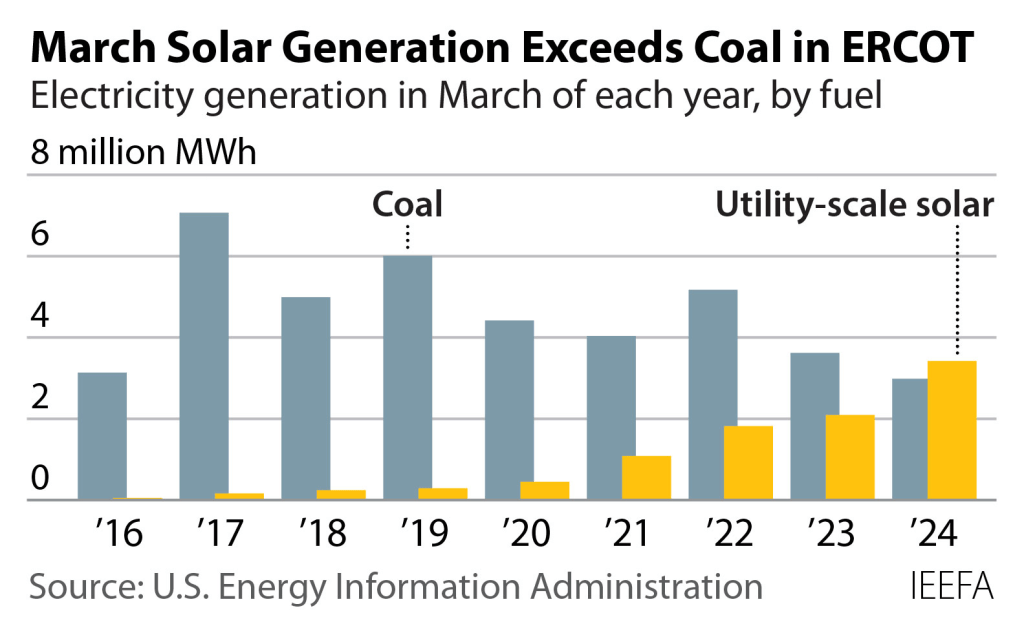
Solar surpassed coal’s output in Texas for the first time in any month, with 3.26 million megawatt-hours (MWh) sent to the grid compared to coal’s 2.96 million MWh in March.
ERCOT’s generation data also revealed that coal’s market share fell below 10% for the first time ever, dropping to just over 9%. This decline, which began a decade ago, has accelerated since 2016-17 when solar first appeared in the generation data, as reported by the Institute for Energy Economics and Financial Analysis (IEEFA) today.
In March 2024, solar generation in Texas reached 3.26 million MWh, according to the Energy Information Administration’s (EIA) hourly grid monitor. This increase pushed solar’s share of ERCOT generation to over 10% for the month, another first.

Texas leads in solar capacity among states. Solar generation in Texas has been steadily increasing and gaining momentum. Generation in March 2024 was 1.17 million MWh higher year-over-year, representing a 56% increase.
According to IEEFA, ERCOT data indicates that the system currently operates with 22,710 megawatts (MW) of solar capacity, with plans to expand by almost one-third by the end of 2024 by adding another 7,168 MW of capacity. These figures only account for Texas solar projects with signed interconnection agreements and financing arrangements to connect to the ERCOT grid.
Further growth is expected in Texas in 2025, with projects totaling 20,932 MW of capacity currently in a similar development stage. There are also thousands of additional megawatts of solar capacity in earlier development stages.
In contrast, coal’s market share in the ERCOT market has been steadily decreasing. From 2003 to 2014, coal’s annual share of ERCOT demand ranged from 33-40%. By 2020, coal had dropped below 20% and fell to less than 15% in 2023, supplying only 13.9% of the system’s total demand.
Researchers at IEEFA highlight that “the annual average is not influenced by a few months of extremely low generation. Rather, coal’s market share in ERCOT is decreasing overall, even during peak summer months.”
The decline of coal in Texas is significant as the state has been the largest consumer of coal for power generation in the US. In 2023, Texas burned twice as much coal as the second-ranking state, Missouri, and accounted for 13% of total coal consumption in the US.
Nationally, for the first time, EIA grid monitor data shows that coal’s share of national electricity generation was below 15% throughout March. Coal’s national market share also hit a daily record low on March 29, falling to just 11.25%.
Coal’s poor performance in March is noteworthy, as in recent years, April and May have been when its national market share hit the lowest points. IEEFA researchers state that “it is entirely possible to drop to single digits on some days this spring.”
Read more: Texas installs another big solar + battery storage project
To enhance power reliability and make your home more resilient, consider transitioning to solar with a battery storage system. To find a reputable solar installer near you offering competitive pricing, visit EnergySage, a free service that facilitates the solar switch. They have numerous pre-screened solar installers competing for your business, ensuring top-quality solutions and savings of 20-30% compared to pursuing it independently. It’s free to use, and you won’t receive sales calls until you select an installer and provide your phone number to them.
Your personalized solar quotes are simple to compare online, and you’ll have access to unbiased Energy Advisers to guide you every step of the way. Get started here. – ad*


